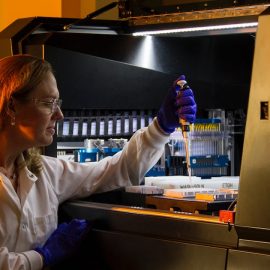

This article is an excerpt from the Shortform book guide to "The Sixth Extinction" by Elizabeth Kolbert. Shortform has the world's best summaries and analyses of books you should be reading.
Like this article? Sign up for a free trial here .
What is the white-nose syndrome? Where did it originate and how did it spread? How does it cause death in hibernating bats?
White-nose syndrome is a disease caused by a cold-climate fungus that affects hibernating bats. Researchers are not sure how exactly the white-nose syndrome kills bats, but they came up with two hypotheses.
Read about the white-nose syndrome, its origin, effects, and how it is implicated in the deaths of bats.
White-Nose Syndrome
In 2007, biologists in New York who studied bats began finding huge numbers of dead bats in the caves where they hibernated. The dead and dying bats had a white powder on their faces.
The next winter, the so-called white-nose syndrome was found on bats in thirty-three caves in four states. In some cases, as many as 90% of the bats died. Twelve species of bats in the U.S. have been affected by white-nose syndrome, including two endangered species and one threatened species.
The fungus causing white-nose syndrome is a cold-climate fungus. In 2010, it was traced to Europe, where it also is widespread. One European species, the greater mouse-eared bat, carries white-nose but doesn’t get sick. Somehow, the fungus was accidentally imported to the U.S., where researchers named it Geomyces destructans.
Bats’ habit of hibernating close together in clusters helped spread the disease. Their slow reproduction rate—a pair has one pup per year—will make it hard for numerous bat species to recover even if some become resistant to the fungus or if scientists can stop the spread.
Scientists aren’t sure how the fungus kills bats. It may irritate their skin to the point that it wakes them up and they fly around expending energy that uses up fat stores. Starving, they then fly outside to hunt for insects in winter and they die. Another theory is that the fungus dehydrates them, which wakes them up to search for water, again using up energy stores.
(Shortform note: Scientists have since reported limited success with spraying bats with a bacteria that kills the fungus. Also, in 2015, researchers reported successfully treating small numbers of bats with gases expelled by certain bacteria. And in 2019, scientists reported some success with an oral vaccine. Read more here.)

———End of Preview———
Like what you just read? Read the rest of the world's best book summary and analysis of Elizabeth Kolbert's "The Sixth Extinction" at Shortform .
Here's what you'll find in our full The Sixth Extinction summary :
- How humans have set in motion a sixth mass extinction
- The 5 mass extinction events that occurred over the last 500 million years
- Why human ingenuity might be able to save the human species from extinction






